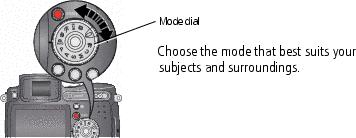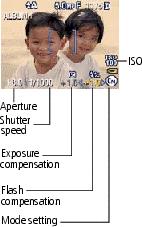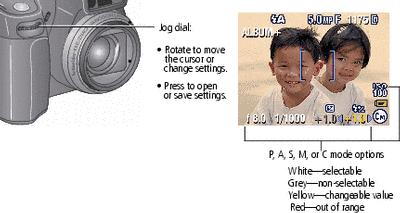Kodak EasyShare DX7590 zoom digital camera — User's guide
Table of Contents > Taking pictures and videos > Picture-taking modes
2 Taking pictures and videos
Picture-taking modes

| Use this mode | For |
|---|---|
|
|
General picture-taking—offers an excellent balance of image quality and ease of use.
|
|
|
Controlling exposure compensation (how much light enters the camera) and flash compensation. The camera automatically sets the shutter speed and aperture (f-stop) based on the scene lighting. Program mode offers the ease of auto shooting with full access to all menu options. Use the jog dial to select settings. (See P, A, S, M, and C modes.) Press the Menu button to change other settings. |
|
|
Controlling aperture, exposure compensation, flash compensation, and ISO speed. Aperture priority mode is primarily used to control depth of field (the range of sharpness).NOTE: The aperture setting may be affected when using optical zoom. Use the jog dial to select settings. (See P, A, S, M, and C modes.) Press the Menu button to change other settings. |
|
|
Controlling the shutter speed, exposure compensation, flash compensation, and ISO speed. The camera automatically sets the aperture for proper exposure. Shutter priority mode is primarily used to prevent blur when your subject is moving. To prevent camera shake, use a tripod for slow shutter speeds. Use the jog dial to select settings. (See P, A, S, M, and C modes.) Press the Menu button to change other settings. |
|
|
Enjoying the highest level of creative control. You set the aperture, flash compensation, shutter speed and ISO speed. Exposure compensation acts as an exposure meter, recommending the proper combination of aperture and shutter speed to produce an acceptable exposure. To prevent camera shake, use a tripod for slow shutter speeds. Use the jog dial to select settings. (See P, A, S, M, and C modes.) Press the Menu button to change other settings. |
|
|
The "user-created" mode. For applying P, A, S, M plus any Custom settings (exposure compensation, flash compensation, ISO speed) which are saved independent of other camera settings. Use the jog dial to select settings. (See P, A, S, M, and C modes.) Press the Menu button to choose a capture mode. (See .) Press the Menu button to change other settings. |
|
|
Capturing video with sound. (See Taking a video.) |
|
|
Viewing your favorites. (See Tagging pictures as favorites.) |
|
|
Point-and-shoot simplicity when taking pictures under 14 special conditions. (See Scene modes.) |
|
|
Subjects that are in motion. Shutter speed is fast. The camera pre-settings are f/2.8–f/3.7, Multi-Pattern Exposure Metering, Multi-Zone Focus, ISO100–ISO 200. |
|
|
Full-frame portraits of people. Allows the subject to be sharp and the background to be indistinct. For best results, position your subject at least 6 ft (2 m) away and fill the frame with a head and shoulder pose. Use Telephoto to exaggerate background blur. The camera pre-settings are f/2.8–f/3.7, Multi-Pattern Exposure Metering, Multi-Zone Focus, ISO 100. |
Scene modes
-
Turn the Mode dial to Scene
 .
. -
Move the Joystick

 to display Scene mode descriptions.
to display Scene mode descriptions. NOTE: If the screen turns off, press the OK button.
-
Press the OK button to choose a Scene mode.
| Use this SCN mode | For | Camera pre-settings | |
|---|---|---|---|
|
|
Close-up |
Subjects closer than 28 in. (70 cm). |
f/2.8–f/3.7, Macro Focus, Center- Weight Metering, Center-Zone Focus, ISO 100 |
|
|
Landscape |
Distant scenery. Flash does not fire. Auto-focus framing marks (Using the auto-focus framing marks) are not available in Landscape. |
f/2.8–f/3.7, Infinity Focus, Multi-Pattern Exposure Metering, Daylight White Balance, ISO 100 |
|
|
Night Portrait |
Reduces red eye of people in night scenes or low-light conditions. Place the camera on a flat, steady surface or use a tripod. |
f/2.8–f/3.7, Multi-Pattern Exposure Metering, Multi-Zone Focus, ISO 140 |
|
|
Night Landscape |
Distant scenery at night. Flash does not fire. Place the camera on a flat, steady surface or use a tripod. |
f/2.8–f/3.7, Infinity Focus, Daylight White Balance, Center-Weight Metering, Daylight White balance, ISO 100 |
|
|
Snow |
Bright snow scenes. |
f/2.8–f/3.7, +1 Exposure Compensation, Center-Weight Metering, Multi-Zone Focus, ISO 100 |
|
|
Beach |
Bright beach scenes. |
f/2.8–f/3.7, +1 Exposure Compensation, Center-Weight Metering, Daylight White balance, ISO 100 |
|
|
Text |
Documents. |
f/2.8–f/3.7, Macro Focus, +1 Exposure Compensation, Center-Weight Metering, ISO 140 |
|
|
Fireworks |
Flash does not fire. Place the camera on a flat, steady surface or use a tripod. |
f/5.6, 2 second exposure, Infinity Focus, Center-Weight Metering, Daylight White Balance, ISO 100 |
|
|
Flower |
Close-ups of flowers or other small subjects in bright light. |
f/2.8–f/3.7, Macro Focus, Daylight White balance, Center-Zone Focus, Center-Weight Metering, ISO 140 |
|
|
Manner/ Museum |
Quiet occasions, like a wedding or lecture. Flash and sound are disabled. |
f/2.8–f/3.7, no sounds, no flash, Multi-Pattern Exposure Metering, Multi-Zone Focus, ISO 100 |
|
|
Self- Portrait |
Close-ups of yourself. Assures proper focus and minimizes red eye. |
f/2.8, Macro Focus, Multi-Pattern Exposure Metering, Multi-Zone Focus, Red-Eye Flash, ISO 100 |
|
|
Party |
People indoors. Minimizes red eye. |
f/2.8–f/3.7, Multi-Pattern Exposure Metering, Multi-Zone Focus, Red-Eye Flash, ISO 140 |
|
|
Children |
Action pictures of children in bright light. |
f/2.8–f/3.7, Multi-Pattern Exposure Metering, Multi-Zone Focus, ISO 140 |
|
|
Backlight |
Subjects that are in shadow or "backlit" (when light is behind the subject). |
f/2.8–f/3.7, Multi-Pattern Exposure Metering, Multi-Zone Focus, Fill-Flash, ISO 100 |
P, A, S, M, and C modes
Settings you change in P, A, S or M modes apply only to pictures taken in those modes. Settings you change in C mode apply only to pictures taken in that mode.
For example, if you change the Color Mode to Sepia while in P, A, S, or M mode, you still retain the default setting of Color for Auto and Scene modes.
| NOTE: | The settings, including Flash, are maintained for P, A, S, M, and C modes—even when you change modes or turn off the camera. Use Reset to Default (see ) to reset P, A, S, M, or C mode to its default setting. |

|

|

|

|

|
Aperture—also known as f-stop, controls the size of the lens opening, which determines the depth of field. Smaller f-numbers, for example f/2.8, refers to a bigger lens opening. Larger f-numbers, for example f/8, refers to a smaller lens opening. Larger f-numbers keep the main subject sharp; good for landscapes and well-lit conditions. Smaller f-numbers are good for portraits and low-light conditions. The highest and lowest aperture numbers may be affected by optical zoom. |
||
Shutter speed—controls how long the shutter stays open. A shaking hand icon  warns of slow shutter speeds. (Use a tripod for slow shutter speeds.) warns of slow shutter speeds. (Use a tripod for slow shutter speeds.) |
|||
|
Exposure Compensation—allows the user to manually adjust the exposure; good for controlling backlit or non-standard scenes. If the picture is too light, decrease the setting; if it's too dark, increase the setting. |
|||
|
Flash Compensation—controls the flash brightness (+0.5, +1.0, –0.5, –1.0). You must be within flash range. Unavailable if flash setting is Off. |
|||
|
ISO—controls sensitivity of the camera sensor (80,100, 200, 400, 800). Higher settings are more sensitive to light, but may produce unwanted "noise" in a picture. You can only use ISO 800 if you are in the 1.8 MP Picture Size setting. (See .) See Tips for better pictures on Tips for better pictures. |
|||
Using the jog dial to change P, A, S, M, or C mode settings
The Jog dial controls the — f-number, shutter speed, exposure and flash compensations, and ISO. Use the Menu button to control all other settings.

-
Turn the Mode dial to P, A, S, M, or C.
The mode options are displayed.
-
Use the Jog dial:
-
Rotate the Jog dial to move the cursor.
 between the available settings.
between the available settings. -
Press the Jog dial to open a setting.
-
Rotate the Jog dial to change the setting
 .
. -
Press the Jog dial to save the setting.
-
-
Press the Menu button to change other settings (see Changing picture-taking settings).
-
Take a picture.
Previous Next
 Auto
Auto
 Program
Program
 Aperture Priority
Aperture Priority
 Shutter Priority
Shutter Priority
 Manual
Manual
 Custom
Custom
 Video
Video
 Favorites
Favorites
 Scene
Scene
 Sport
Sport
 Portrait
Portrait 












